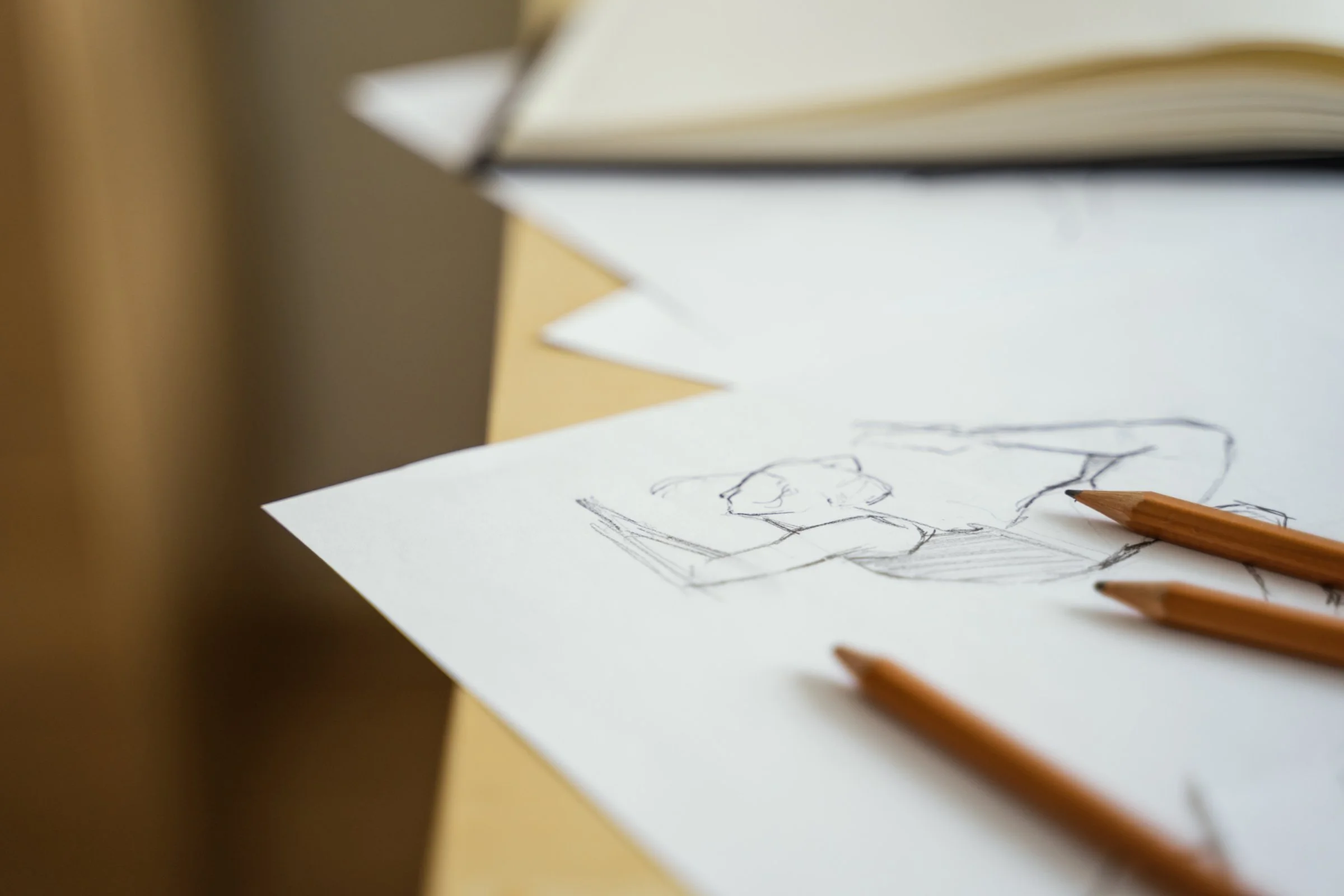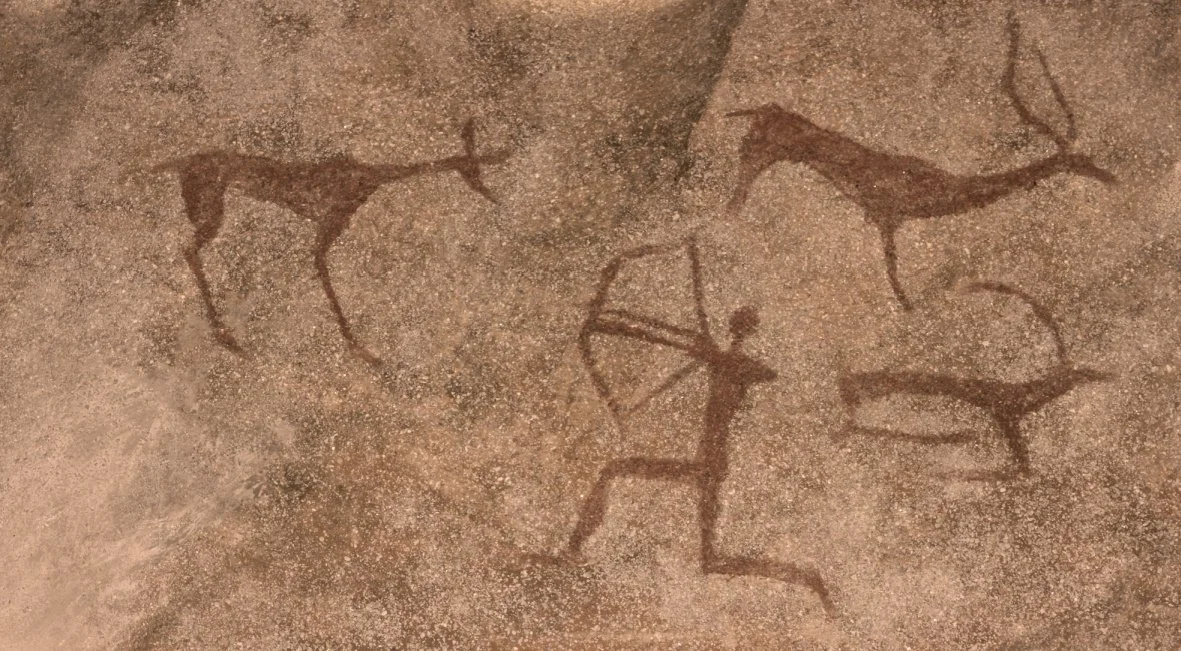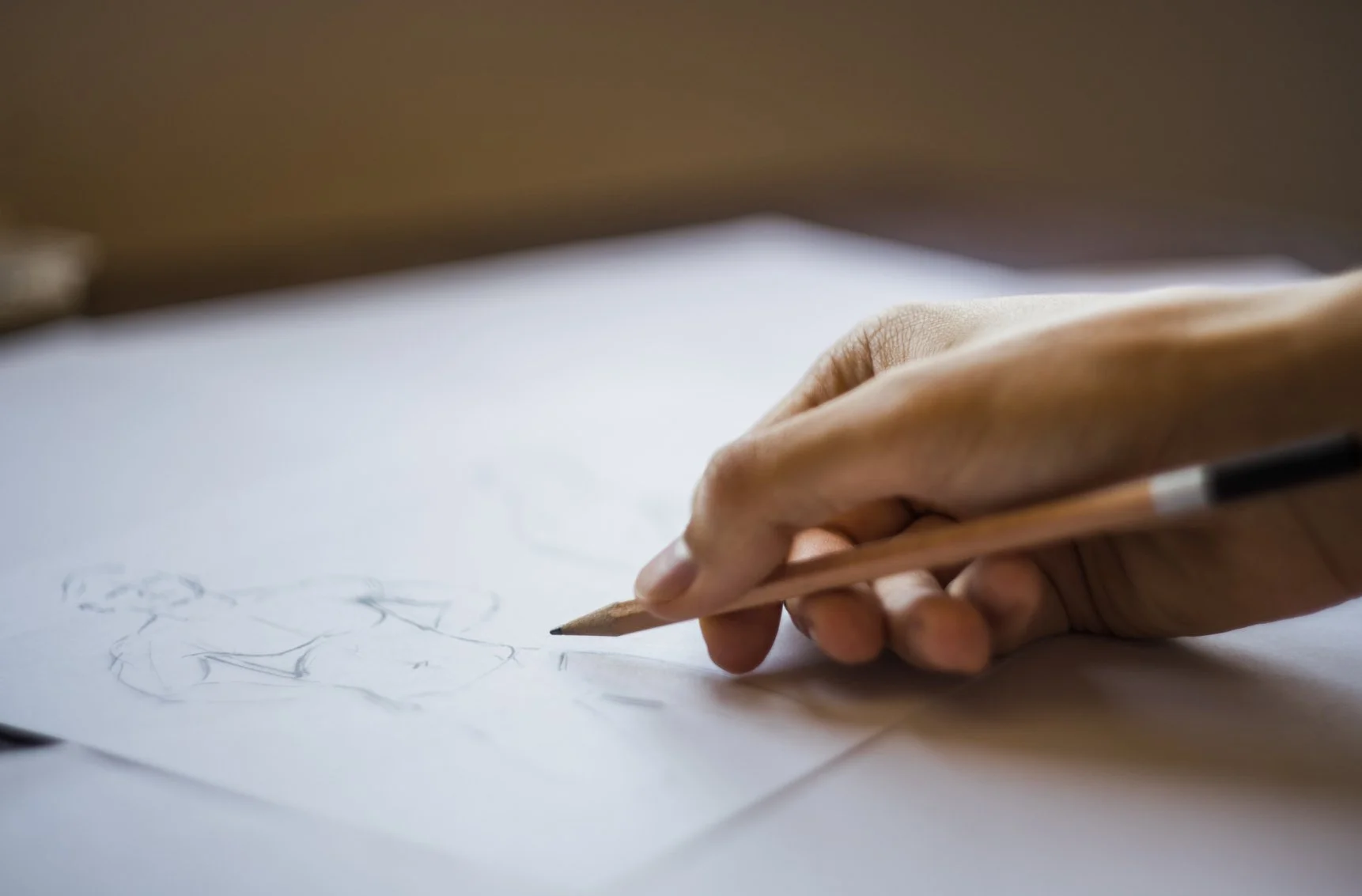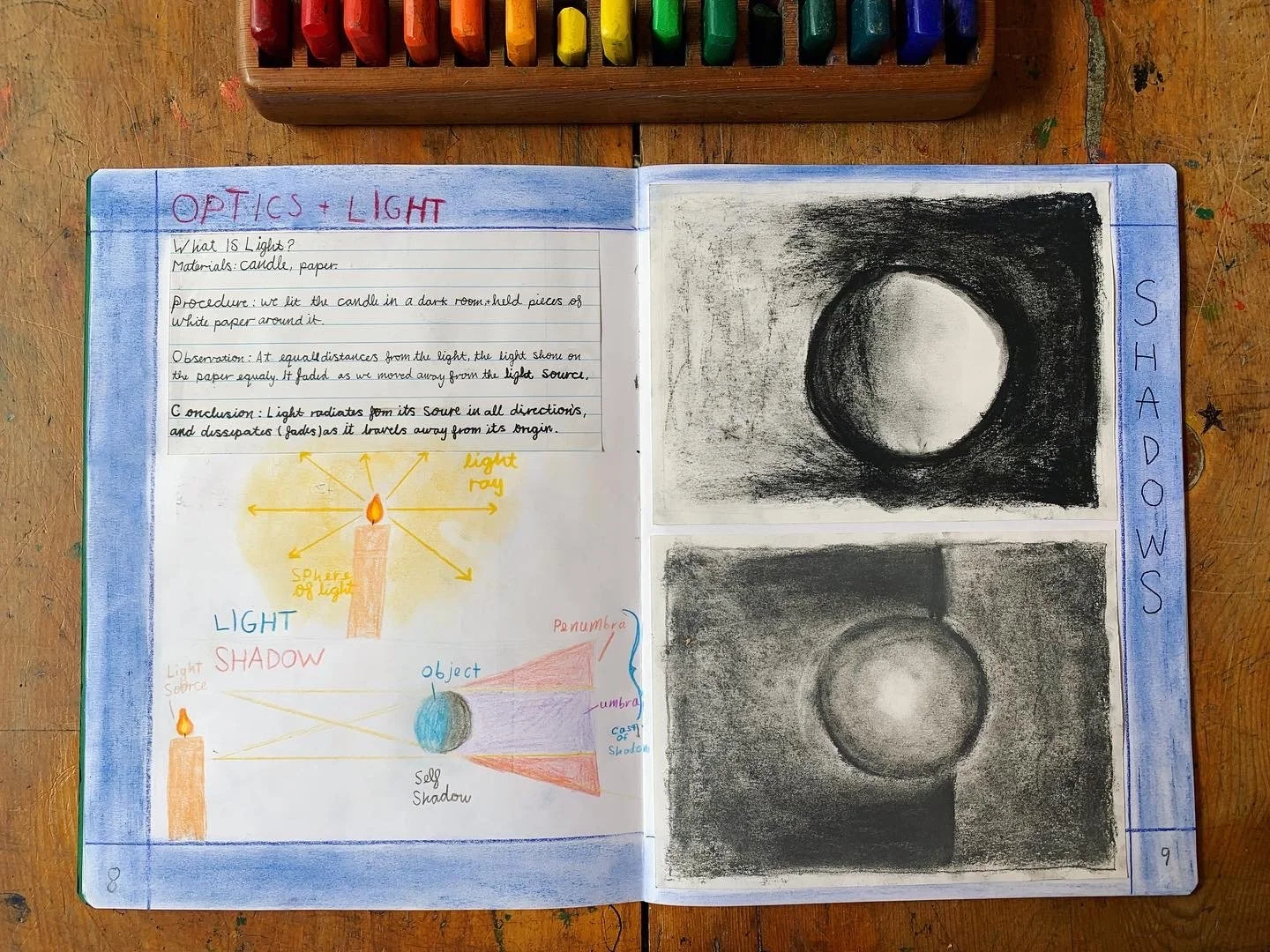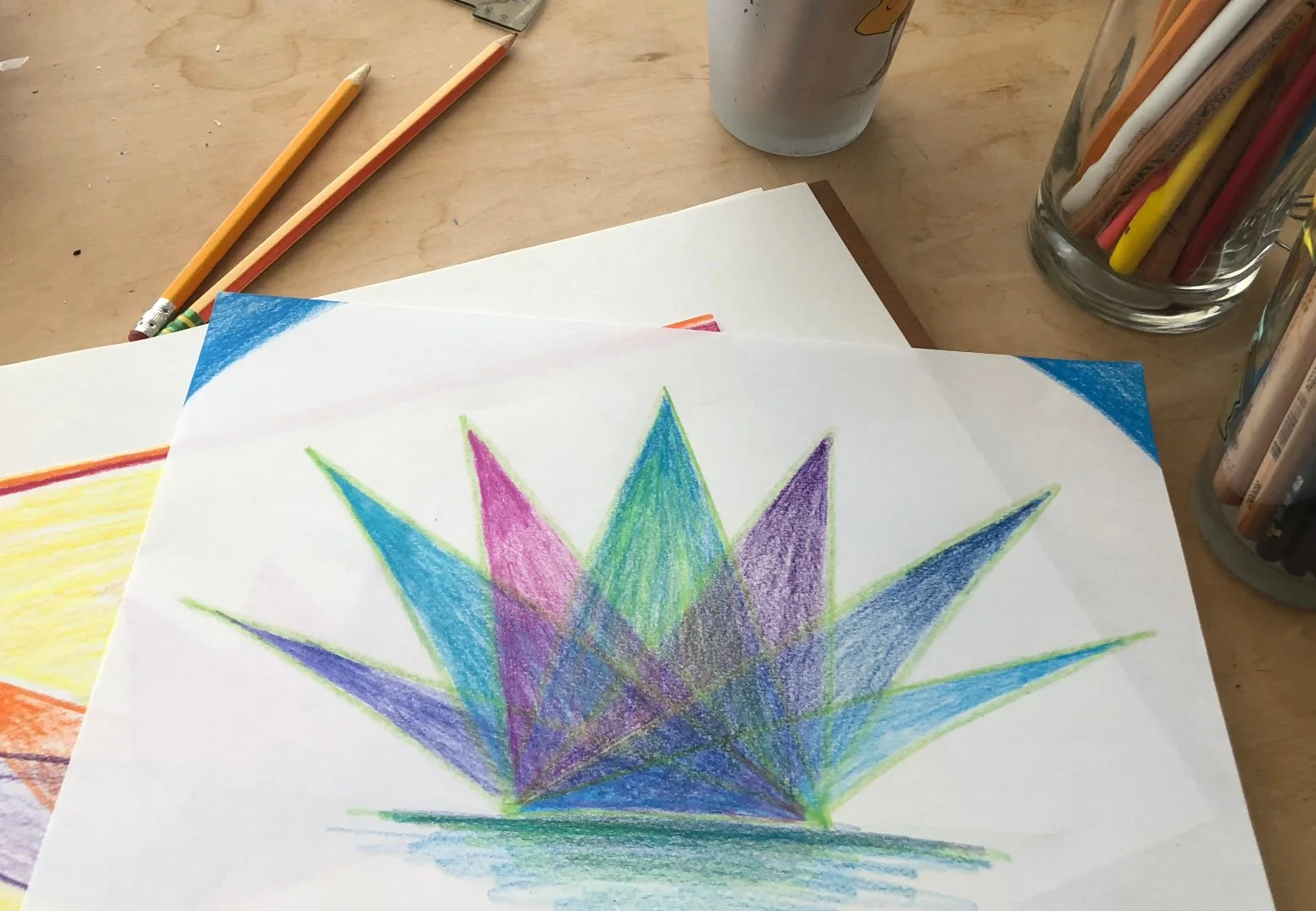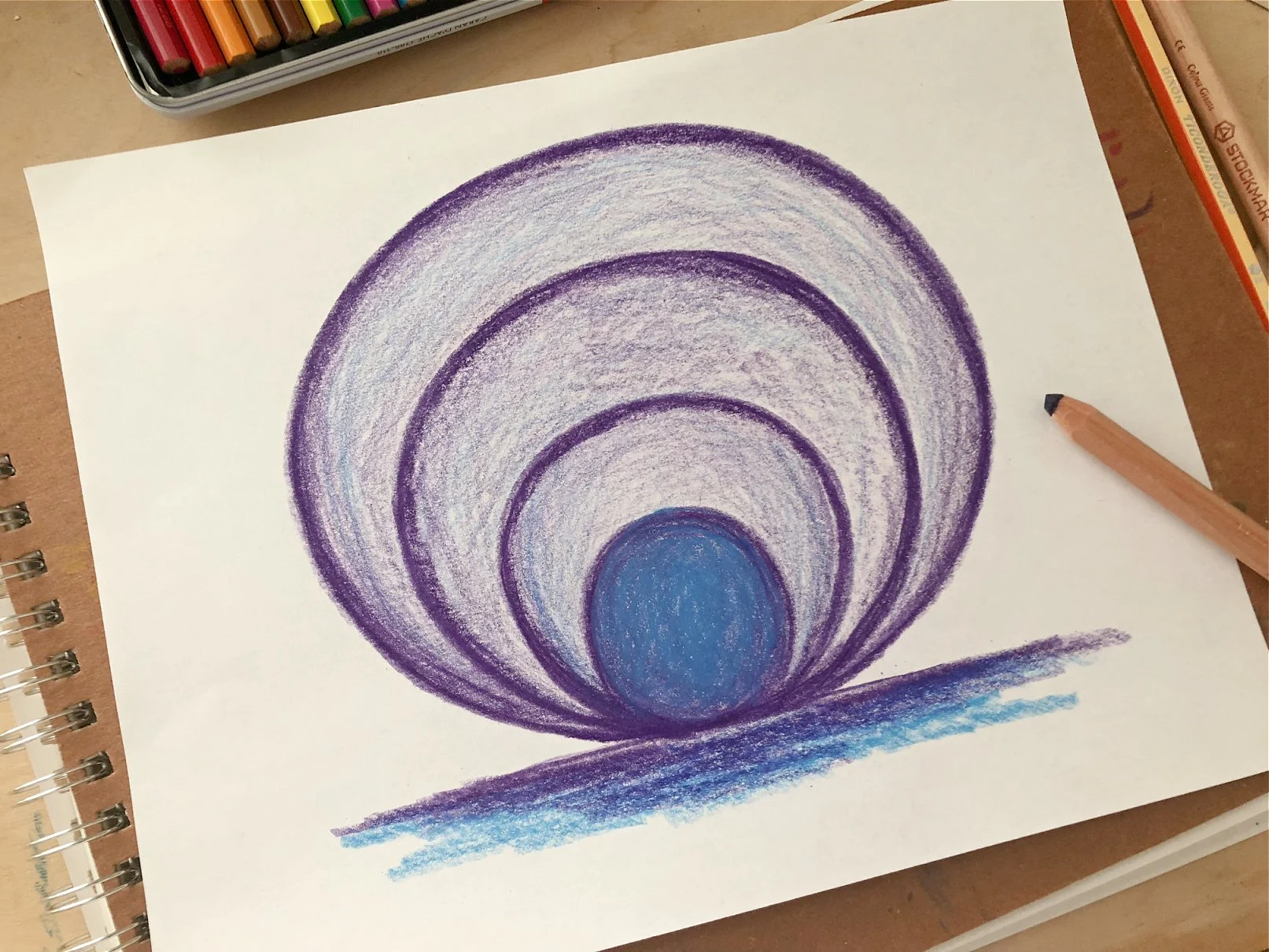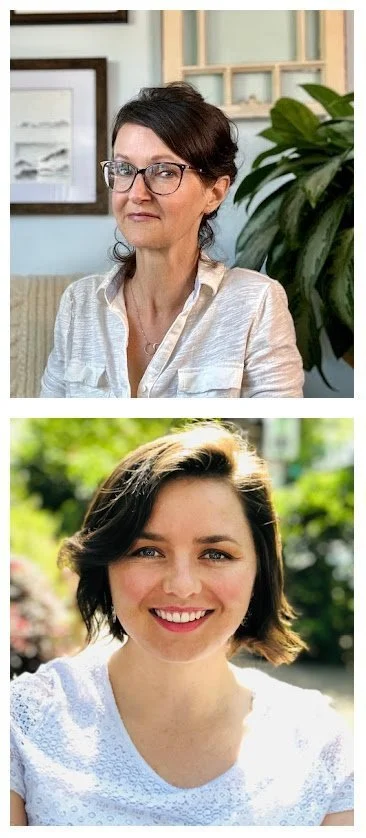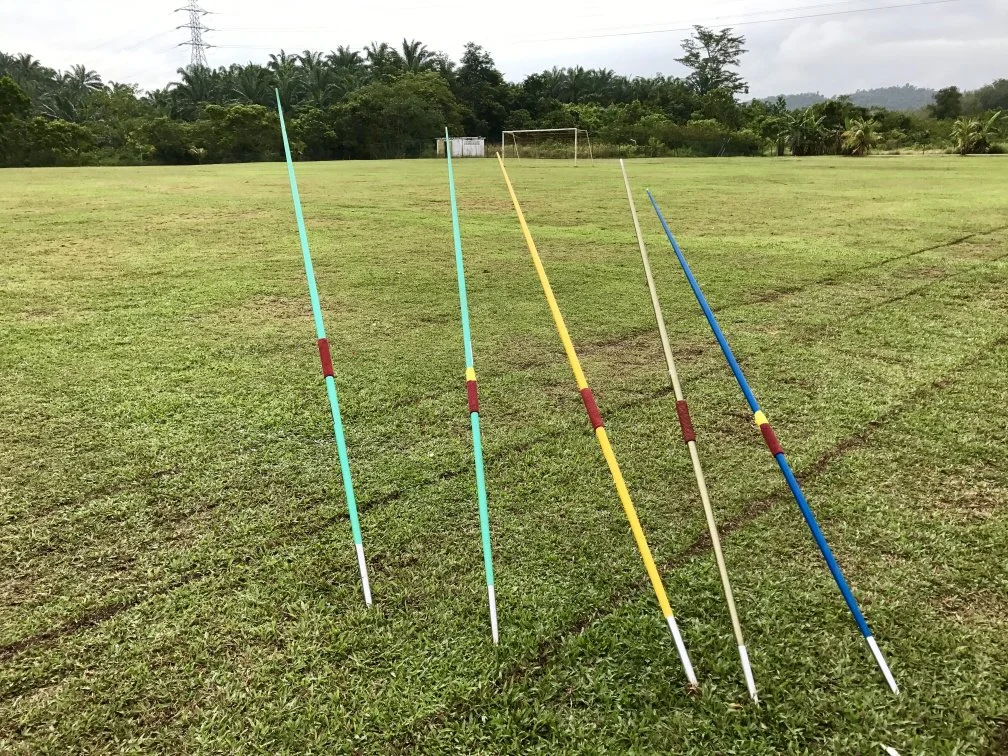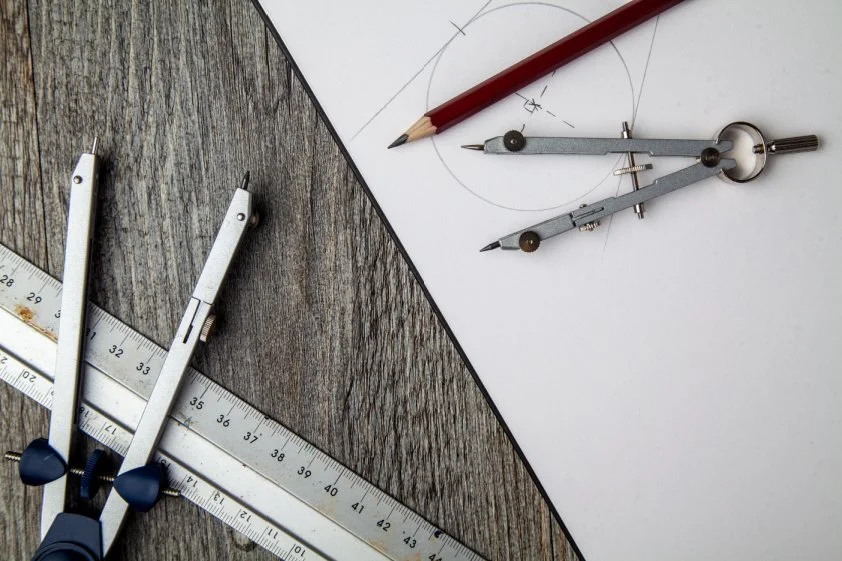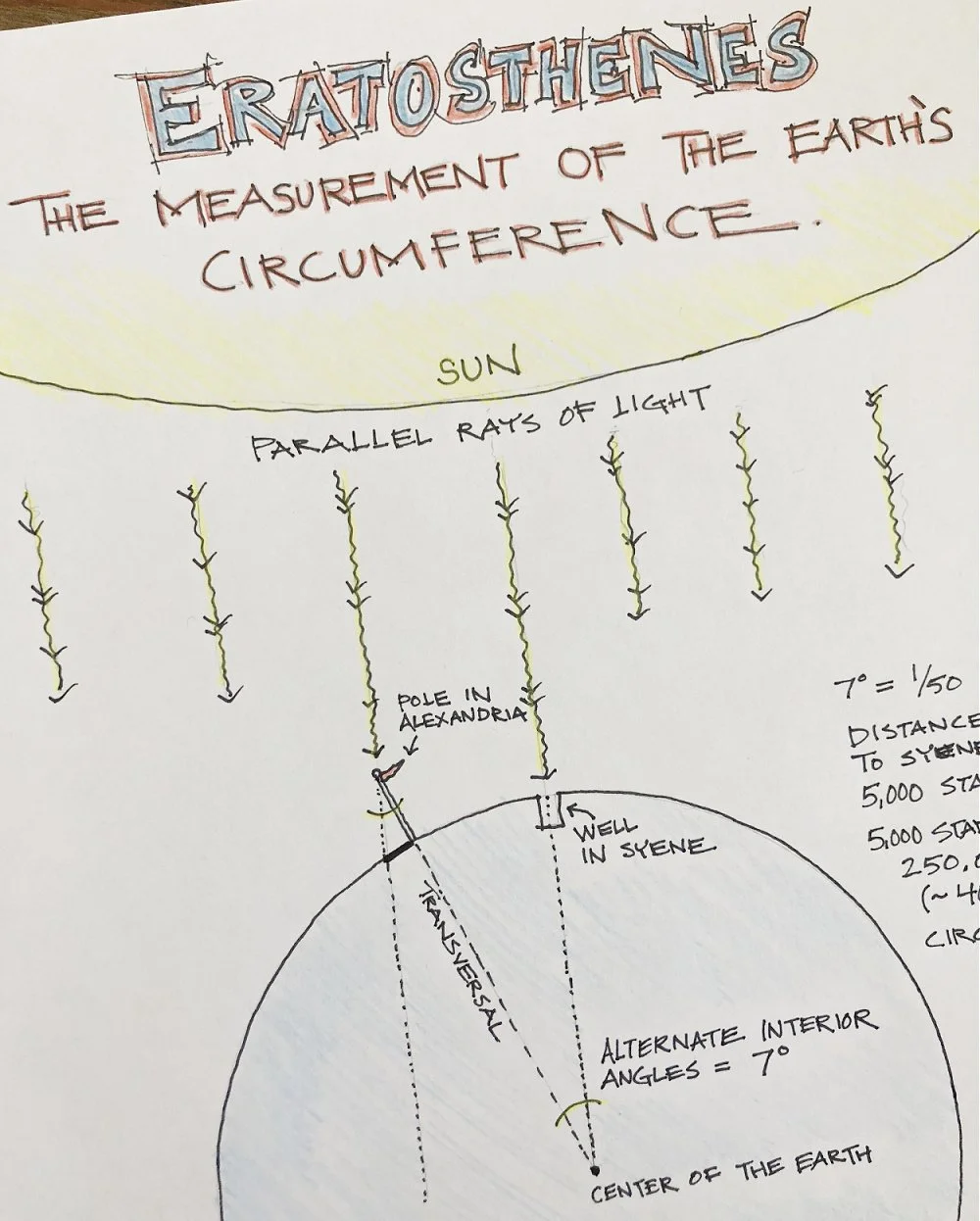
Waldorfish Blog
The Human Form in Motion: Why Figure Drawing Belongs in the Middle Grades of Waldorf Education
Figure drawing can be a simple activity that provides meaningful impact.
By the time a Waldorf student reaches seventh and eighth grade, their curriculum takes a bold step into the world of ideas, invention, and individuality.
They study anatomy, physiology, physics, chemistry, art history, and revolutions - both industrial and ideological. The thread running through all these blocks? A deeper understanding of the human being - not only how we function, but how we think, evolve, and express ourselves in the world.
It’s no coincidence that this is also the time when figure drawing steps into focus in a new and meaningful way.
A Longstanding Thread, Now Evolving
Figure drawing has always had a place in Waldorf art education. It shows up in the second grade Saints drawings, fourth grade Man and Animal block, and sixth grade portrait studies. But in the middle school years, this thread weaves into something more intentional and mature.
Figure drawing is an ancient practice.
Seventh and eighth graders no longer draw the human figure as a character in a story or a part of a historical tale. Instead, the human figure becomes the subject itself. This shift mirrors the adolescent’s changing worldview. Just as they begin to examine themselves and their peers more deeply - physically, socially, emotionally - they’re asked to do the same on the page.
Here, artistic expression and realism come together in a new way. Students learn the proportions of the human body, how bones and joints support movement, and how posture and gesture communicate emotion. It’s a beautiful marriage of observation and imagination.
From Observation to Expression
In the middle grades, we often begin with gesture drawings - quick, expressive sketches that capture movement rather than detail. A person walking, reaching, twisting - these simple poses invite students to see the body not as a fixed form, but as something alive, dynamic, and expressive.
Proportional studies also begin here. Students explore relationships:
How many “head lengths” tall is an average adult?
How wide are the shoulders compared to the head?
Where do the wrists fall in relation to the hips?
But it doesn’t stop at measurement. These explorations naturally spark deeper conversations:
How does one communicate bravery with their body? Sadness? Anxiety? Confidence?
What does it mean when someone stands tall with arms relaxed at their sides versus hunched with a lowered head?
This is more than drawing—it’s social-emotional learning through art.
Don’t hesitate, give figure drawing a try!
A Crucial Conversation for the Middle Grades
This kind of artistic inquiry is especially meaningful in middle school. Students are developing new social awareness. They’re navigating friendships, boundaries, and identity. Understanding how humans communicate through non-verbal cues- and how to observe them objectively - is powerful. It fosters empathy and self-awareness.
Here, the educator’s role is to shift focus from scrutiny to celebration. We are not drawing to judge or idealize the body, but to appreciate its ability to balance, to express, and to move with intention
Bringing in Art History & Storytelling
Art history naturally enriches figure drawing work. Classic paintings and sculptures offer timeless examples of how gesture communicates.
What emotion was Emanuel Leutze trying to convey by painting George Washington standing tall in profile, chin up, gaze forward in Washington Crossing the Delaware?
What story were early cave artists telling when they etched upright warriors, spears in hand, into stone?
What does a dancer’s curved spine and extended arms express in Degas’ sketches?
There are no wrong answers - only opportunities for discussion.
This is what figure drawing in middle school offers: a chance to merge observation, interpretation, and personal insight.
For Parents and Educators Supporting This Work
Process over product, and enjoy!
If you feel unsure about your own drawing skills, take heart. You don’t need to be a professional artist to guide this work! What matters is modeling curiosity, showing up alongside your child, and being open to discovery.
At Waldorfish, we teach figure drawing as a progression - one that’s developmentally appropriate and inviting, not intimidating. In our Diving Deeper course (the next step after Weekly Art Foundations), we offer guided lessons in gesture drawing, proportion, and expressive form - designed with middle schoolers and their parents in mind.
Ready to Take the Next Step?
If you’re looking to deepen your middle schooler’s Waldorf art education, explore our Weekly Art Diving Deeper course.
It’s the perfect companion to the growth, complexity, and creativity blooming in your students at this stage.
About the Authors
Robyn Beaufoy is Waldorfish’s CEO, and also a course instructor for Simple Season, Waldorf Art for Beginners, and Weekly Art Foundations. You’ll find her intuitive touches and influences throughout everything Waldorfish offers. Robyn has been in the world of education for over 25 years, with an MA in Education and a certification in Waldorf teaching - she also homeschooled both of her children for some of that time. In 2012 Robyn co-founded Waldorfish.com, creating it with the vision of making Waldorf inspired-art and pedagogy more accessible, joyful, and doable for homeschoolers all over the world.
Caitlin Amajor is Waldorfish’s course instructor for Geometry grades 5 & 6, and Botany, as well as our Administrative Assistant. From a young age, Caitlin has been immersed in Waldorf education, attending a Waldorf school from K-8. After receiving a BA in History, Caitlin gained her certification in Waldorf teaching, and spent seven years as a Waldorf class teacher in the upper grades. With a special fondness for watercolor painting and geometry, Caitlin loves bringing Waldorf education to her students all over the world, and seeing their own individuality and style bloom from the curriculum!
Waldorf Sixth Grade Curriculum: Exploring the Natural World through Physics
In sixth grade, it’s time for a whole new way of exploring the natural world: the study of Physics!
As the child is leaving the comforting world of early childhood and entering into a new realm, it’s the perfect time to re-enliven and re-invigorate their sense of awe and love for the natural world, all while discovering scientific phenomena and law.
An example main lesson book page illustrating experiments around Optics, from our sixth grade Physics course!
While a Waldorf student has been exploring nature throughout the grades, middle school marks a shift in the curriculum where scientific study becomes far more structured and a key area of focus. These blocks call upon the educator to teach in a new way using phenomenology (Huh? Click here for more) and for the student to approach their learning from a different perspective.
So, what’s sixth grade physics all about? The block starts with the basics, and calls upon the student to use their observational and practical skills to discover the laws of sound, heat, light, magnetism, and electricity.
The curriculum typically begins with the study of acoustics, where students explore the nature of sound. They learn how sound is produced by vibrations and how it travels through different materials. Through activities involving musical instruments and simple sound experiments, students investigate phenomena like pitch, echo, and resonance.
The curriculum also introduces students to the principles of heat and thermodynamics. They examine how heat is generated, how it moves, and how it affects materials—causing them to expand, contract, or change state. This is a particularly fun aspect of the block; seeing an educator use a blowtorch is always exciting (when done safely, of course!)
The study of magnetism in action!
When studying optics (also referred to as the study of light) students observe the characteristics of light and how it behaves in our world. With the use of a completely blacked out room, students observe how light is invisible, how it can create a camera obscura, and explore the vast world of color and shadow.
Magnetism is explored through the use of simple magnets and iron filings, allowing students to observe magnetic attraction and repulsion, and the concept of magnetic fields. They experiment with magnetic materials and learn about the basic properties of magnets, including polarity.
Finally, students are given an introductory look at static electricity using balloons, various kinds of fabric and textiles, and other materials. Though explored simply, this portion is setting the stage for 8th grade physics when students will build motors, explore circuits, and more!
This 6th grade Physics block sets the foundation for the future as the curriculum deepens in complexity, where physics will be visited again in 7th and 8th grade.
It’s an exciting shift where the educator and student enter a new realm of observation, investigation and exploration!
More on the blog:
About the Authors
Robyn Beaufoy is Waldorfish’s CEO, and also a course instructor for Simple Season, Waldorf Art for Beginners, and Weekly Art Foundations. You’ll find her intuitive touches and influences throughout everything Waldorfish offers. Robyn has been in the world of education for over 25 years, with an MA in Education and a certification in Waldorf teaching - she also homeschooled both of her children for some of that time. In 2012 Robyn co-founded Waldorfish.com, creating it with the vision of making Waldorf inspired-art and pedagogy more accessible, joyful, and doable for homeschoolers all over the world.
Caitlin Amajor is Waldorfish’s course instructor for Geometry grades 5 & 6, and Botany, as well as our Administrative Assistant. From a young age, Caitlin has been immersed in Waldorf education, attending a Waldorf school from K-8. After receiving a BA in History, Caitlin gained her certification in Waldorf teaching, and spent seven years as a Waldorf class teacher in the upper grades. With a special fondness for watercolor painting and geometry, Caitlin loves bringing Waldorf education to her students all over the world, and seeing their own individuality and style bloom from the curriculum!
Waldorf Botany Curriculum: Shifting Focus to the Higher Plants
A watercolor painting of the “higher plants” from our Botany course!
In Waldorf fifth grade botany, the second block focuses on the “higher plants,” or those that have true leaves, roots, stems, and flowers!
(To learn more about the first block and its focus, click here).
The second block, often done in the spring, is the perfect time to study these more complex plants with new methods.
Why?
The curriculum meets the developing fifth grader right where they are, which is on the cusp of entering middle school!
The growing fifth grader is ready to use their observational skills in more complex and challenging ways, and the educator can begin to introduce concepts using phenomenological techniques, preparing them for middle school science curriculum.
The shift in the Botany curriculum is notable; the fifth grader is no longer living so much in the world of imagination and story, but instead, is eager to explore and learn more about the world around them.
In Botany, the second block closely follows the growth of a plant from the very beginning. As the fifth grader is growing and changing rapidly, it’s the perfect time to connect with nature and see how it blossoms as well.
An example main lesson book page from our Botany course.
Commonly, students study seeds, germination, photosynthesis, flowering, and seed dispersal, all the while incorporating opportunities to connect to plant life thriving in their own region. As well, students may explore trees, categorize plants according to their characteristics (monocots and dicots), and so much more- the possibilities are endless!
This block provides an opportunity for the educator to bring the students directly into the learning process, and begin to nurture observational skills and the ability to come to educated conclusions.
It’s a time to do, feel, see, smell, taste, and use all of the senses to connect with the plant world!
From sprouting seeds, to dissecting flowers, the curriculum provides all kinds of opportunities to enliven the students’ connection to the vast world of Botany.
Wondering where to begin?
Most simply, and perhaps more meaningfully, start outside! Gain inspiration, connect with nature, and explore the beauty of the higher plants out in nature; it really is the best place to begin.
Our Botany course provides a full year’s worth of curriculum for the school year, including two full blocks, hands-on demonstrations, and so much more.
About the Authors
Robyn Beaufoy is Waldorfish’s CEO, and also a course instructor for Simple Season, Waldorf Art for Beginners, and Weekly Art Foundations. You’ll find her intuitive touches and influences throughout everything Waldorfish offers. Robyn has been in the world of education for over 25 years, with an MA in Education and a certification in Waldorf teaching - she also homeschooled both of her children for some of that time. In 2012 Robyn co-founded Waldorfish.com, creating it with the vision of making Waldorf inspired-art and pedagogy more accessible, joyful, and doable for homeschoolers all over the world.
Caitlin Amajor is Waldorfish’s course instructor for Geometry grades 5 & 6, and Botany, as well as our Administrative Assistant. From a young age, Caitlin has been immersed in Waldorf education, attending a Waldorf school from K-8. After receiving a BA in History, Caitlin gained her certification in Waldorf teaching, and spent seven years as a Waldorf class teacher in the upper grades. With a special fondness for watercolor painting and geometry, Caitlin loves bringing Waldorf education to her students all over the world, and seeing their own individuality and style bloom from the curriculum!
Waldorf 5th Grade: Weaving Geometry Throughout the Curriculum
“The Crown” form found in our grade five geometry course.
Waldorf fifth grade curriculum includes a variety of subjects to explore.
It is particularly exciting because it is the first year history and science are introduced as stand-alone areas of study. Ancient Civilizations, Greek Mythologies and History, Botany, Decimals, and much more are explored using a variety of approaches, including (but not limited to!) art, music, and story.
One of our favorite aspects of the fifth grade curriculum is Geometry. Through a freehand approach, the fifth grader builds a strong relationship to geometry within their own bodies, and is prepared for the more complex work with tools that they will experience in sixth grade.
Geometry can be taught in block form in fifth grade (where the lessons are taught every school day over a three or four week period) and/or can also be sprinkled in throughout the school year - it is an ideal subject to be woven into other aspects of the curriculum.
Geometry fits in just about everywhere in the fifth grade year- here are several suggestions if you’re interested in weaving it all together:
Javelin throwing is a big part of the Pentathlon and can be a full-body way of exploring parallel lines, angles, arcs, and much more from the geometry curriculum!
Greek history: Greek architecture and art is filled with familiar forms that are found all throughout geometry in fifth grade and will also bring back an opportunity to review form drawing as well.
Movement: As students prepare for the Waldorf Pentathlon (a common activity for fifth graders), students and educators can explore the geometry behind movement. Angles of the javelin throw, symmetry in running strides, and the circular motion in discus throwing all connect back to geometry in a real-world way.
Botany: Flowers and leaves unfurl, bloom, and structure themselves in beautiful patterns naturally! Take the time to find these patterns through nature sketching, or on a hike, and discover just how orderly nature really is.
Ancient Civilizations: Mandalas evoke the beauty of Ancient India, the sculpture and carvings of Ancient Persia have repeating patterns- there is endless inspiration here for things to be created on main lesson book pages and other artwork!
Map drawing: Fifth grade is a wonderful time to bring in a more strategic and skillful approach to map drawing by using freehand grids. Maps can be drawn of students’ home towns, countries, ancient kingdoms, and much more.
One of the most beautiful aspects of Waldorf Education is how various subjects seamlessly weave into each other, and geometry is no exception!
Math into art, history into nature studies, music into movement- the possibilities are endless when it comes to creating a rich tapestry with the fifth grade curriculum.
Explore our blog!
About the Authors
Robyn Beaufoy is Waldorfish’s CEO, and also a course instructor for Simple Season,, Waldorf Art for Beginners, and Weekly Art Foundations. You’ll find her intuitive touches and influences throughout everything Waldorfish offers. Robyn has been in the world of education for over 25 years, with an MA in Education and a certification in Waldorf teaching - she also homeschooled both of her children for some of that time. In 2012 Robyn co-founded Waldorfish.com, creating it with the vision of making Waldorf inspired-art and pedagogy more accessible, joyful, and doable for homeschoolers all over the world.
Caitlin Amajor is Waldorfish’s course instructor for Geometry grades 5 & 6, and Botany, as well as our Administrative Assistant. From a young age, Caitlin has been immersed in Waldorf education, attending a Waldorf school from K-8. After receiving a BA in History, Caitlin gained her certification in Waldorf teaching, and spent seven years as a Waldorf class teacher in the upper grades. With a special fondness for watercolor painting and geometry, Caitlin loves bringing Waldorf education to her students all over the world, and seeing their own individuality and style bloom from the curriculum!
Looking for something?
Welcome to Waldorfish! We started this adventure in 2012 out of a desire to make Waldorf training more accessible to class teachers in remote locations and to homeschooling families everywhere! Read more, click here.
WE WON! Our Weekly Art courses were voted “best interactive art program.” Learn more about the award, here.
A few of our most popular blog posts:
